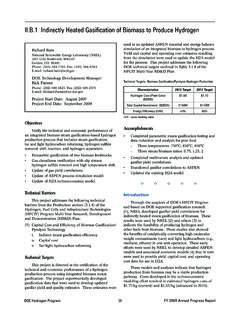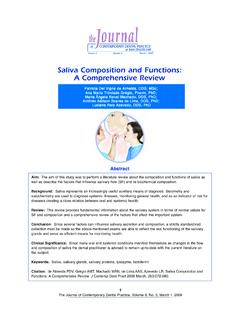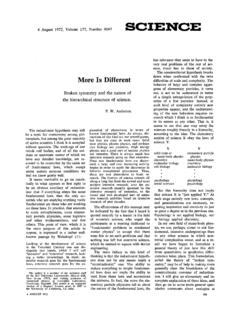Transcription of Manufacturing Competitiveness Analysis for Hydrogen ...
1 Manufacturing CompetitivenessAnalysis for Hydrogen Refueling Stationsand Electrolyzers Ahmad Mayyas, Margaret Mann ( )National Renewable Energy Laboratory June 14, 2018 DOE Hydrogen and Fuel Cells Program 2018 Annual Merit Review and Peer Evaluation Meeting Project ID # MN017 This presentation does not contain any proprietary, confidential, or otherwise restricted information. Overview Timeline Project start date: April 2015 Project end date: June 2018 Percent complete: 90% Budget Total project funding DOE share: $719 K Contractor share: Funding received in FY18: $0 Technical Barriers Cross-Cutting Fuel Cell Barriers F. Manual Stack Assembly I. Lack of Standardized Balance-of -Plant Component Hydrogen Generation by Water Electrolysis F. Capital Cost K. Manufacturing Collaborators Argonne National Laboratory Sandia National Laboratories Pacific Northwest National Laboratory Other Industry Advisors and Experts 2 Relevance & Goals To develop detailed bottom-up Manufacturing cost Analysis for key systems/parts in the Hydrogen refueling station (HRS).
2 To identify cost drivers for key systems in the Hydrogen refueling stations ( , compressors, storage tanks, dispenser, coolers and heat exchanger) To identify cost drivers for onsite Hydrogen production systems (PEM and alkaline electrolyzers) To investigate effect of economies of scale and learning experience on the cost of the onsite Hydrogen production systems 3 Approach Global assumptions ( , capital, tool life, building life, etc.) Local assumptions by country ( labor, energy cost, building cost, etc.) Manufacturing cost model (PEM and Alkaline electrolyzer) Benchmark with existing/future commercial products Compare to other cost studies (H2A, E4 Tech, etc.) HRS rollouts 2005-2017 (PNNL, CEC, NEDO, HySUT, NOW, CEP, etc.) HRS trade flows (HRS developers, part suppliers) Supply chain maps HRS technology (gaseous, liquid, onsite) system components Key outputs 1) HRS and onsite H2 system Manufacturing costs and minimum sustainable prices 2) International trade flows & supply chain maps 3) Estimation of future HRS technologies cost and effects on H2 price Minimum sustainable price (M f g cost, balance of plant, profit margin, etc.
3 Qualitative factors ( skilled labor, existing supply chain, regulations, tax policy, etc.) Quantifying these factors ( learning rate, scrap rate reduction, etc.) 4 Accomplishment- Global HRS Trade Flows Green/Blue colors within same country represent domestic shipments only Updated Map NREL Analysis 2017 5 Comparison Between PEM And AlkalineElectrolyzers PEM electrolyzers have larger current and power densities, shorter startup time and higher system price (in $/kW) Characteristics Alkaline PEM Unit Notes Current Density - - A/cm2 C kWh/kg-H2 Electrolysis system only. Excluding storage, compression and dispensing minutes Ye a r Including power supply, system control and gas drying. Excluding grid connection, external compression, external purification and H2 storage Power Density Operating Temperature Electricity Consumption (Median) Min. Load Startup Time from Cold to Min. Load System Efficiency (LHV) (Median) System Lifetime (Median) System Price Reference voltage = volt - W/cm2 60 80 50 84 50 73 47 73 (53) (52) 20 - 40% 3 10% 20 min- 60+ 5 15 45-67% 45 71% (63%) (63%) 20-30 10-30 (26) (22) $760 $1,100 $1,200-$1,940 ($930) ($1,570) Sources of data: Bertuccioli et al.
4 , 2014, NREL Analysis 2017 6 PEM Electrolyzer System Design Stack is the core of the PEM electrolysis system. Balance of plant parts usually outsourced from reliable vendors Oxygen/ Water Phase Separator Heat Exchanger Electrolyzer Stack Water/H2 Separator Pump City Water Dryer H2 Low Pressure Storage Transformer Rectifier High Voltage Supply Back Pressure Regulator H2 H2O Controllable Valve O2 DI Water Water Cleaner Combustible Gas Detector Hot Water Demister Demister 7 Accomplishment-PEM Electrolyzer Functional Specifications for Analysis Current and power densities are key parameters in the cell design Stack Power 10 20 50 100 200 500 1,000 2,000 5,000 10,000 kW single cell amps 1224 A current density A/cm2 reference voltage V power density W/cm2 Pt-Ir loading- Anode g/m2 PGM loading Cathode g/m2 single cell power W Cells per system 5 10 25 50 101 252 505 1010 2524 5048 cells stacks per system 1 1 1 1 1 1 2 4 10 20 stacks cells per stack 5 10 25 50 101 252 252 252 252 252 cells Current density and reference voltage were estimated using average values for several commercial PEM electrolyzers Part Assumptions Notes Membrane Nafion 117 (Purchased) PFSA (PEEK, PBI) Pt Pt -price= $1500/t r.
5 O z DOE current value CCM Spray Coating Platinum loadings: Anode= 7g/m2 (Pt) Cathode= 4g/m2 (Pt-Ir) Porous Transport Layer Sintered porous titanium Porosity=30% Ti-price= $ Seal/Frame Screen printed PPS-40GF or PEEK Seal: cm from each side for MEA seal bonding Plates Stamped stainless steel 316L Coated plates ( plasma Nitriding) PPS-40GF: poly Phenylene Sulfide (40% Glass fiber filled) 8 Accomplishment-Alkaline ElectrolyzerFunctional Specifications for Analysis Current and power densities are key parameters in the cell design Commercial alkaline electrolyzers can have large cells (~ in diameter ) Electrolyte solution (Water+30% KOH) See Vogt et al., 2014 Functional Cell Design Electrodes Raney-nickel PVD + Leaching to get the required porosity Part Materials Notes Membrane m-PBI Cast membrane using doctor-blade machine Porous Transport Pure Nickel Corrosion resistance in alkaline solution Layer Sheets Frame PPS-40GF or PEEK Injection molding Plates Nickel plates Surface treatment of high purity sheets PVD: physical vapor deposition PPS-40GF: poly Phenylene Sulfide (40% Glass fiber filled) 9 Coil - Stainless Steel 316L Blanking Stamping Cleaning (Chemical Bath) Cleansing plasma Nitriding N2 Gas + High Voltage and Temp.
6 plasma Nitriding Furnace Final Plate Accomplishment- PEM - Bipolar Plate Cost Model Nitriding or other special coating processes used to improve durability of bipolar plates in acidic environment Case Hardening (Nitriding) 10 Accomplishment- PEM Stack Assembly Cost Model Stack assembly is still semi-manual and there is good room for improvements (robots, flexible assembly line) Semi-Automatic assembly line 3 workers/line PPS-40GF Adhesive Materials for MEA Compression bands or tie rods Stainless steel 316L end plates (thickness 30 mm) Image from: Mayyas et al., 2016 11 Accomplishment- PEM Stack Assembly Cost Model Stack assembly is a labor-intensive process. Capital and building cost dominate at low production rates 65 kg H2/day 385 kg H2/day 12 Accomplishment- PEM Electrolyzer Stack Cost based manufacturers have advantages of 1) longer experience ( , learning rate), and 2) lower energy cost except for China and Mexico (still has smaller effect in the stack cost) China s advantage relative to the is driven by lower labor (includingstack assembly), building, and energy costs Mexico s advantage relative to the is driven by lower labor (includingassembly), and building costs Relative cost of the stack is higher inEurope because of the higher laborand energy costs Relative cost of the stack is higher inJapan and Canada (in relative to )
7 Because of the higher labor costs 385 kg H2/day 385 kg H2/day 13 Accomplishment- PEM Electrolyzer Stack Cost Larger production rates could also play role in reducing the cost (economies of scale for the stack modules) and balance of plant (not shown in these charts) China s advantage relative to the is driven by lower labor (including assembly), low material cost, building and energy costs Mexico s advantage relative to the is driven by lower labor (including assembly), and building costs Relative cost of the stack is higher in Europe because of the higher labor and energy costs Relative cost of the stack is higher in Japan and Canada (in relative to ) because of the higher labor costs. 385 kg H2/day 385 kg H2/day 14 Accomplishment- PEM Electrolyzer System Cost System cost by component (stack & BOS) Unlike the stack, balance of plant is not manufactured in house and most of its parts are outsourced from reliable vendors Balance of plant shares >50% of total system cost, and assumed to have same cost across all countries in the list Power electronics dominate the balance of plant cost (AC/DC rectifiers are very expensive compared to the DC/DC converter) Connecting electrolyzer to DC source ( , wind, PV) may reduce the cost of power electronics in the electrolysis system ( , AC-DC rectifier cost vs.)
8 DC-DC convertor cost) Stack Stack Balance of plant Balance of plant 15 Proximity to customers: shipping costs, exchange of technical specifications Electrolysis Systems Value Chain Raw Materials Membrane Electrode Assembly Stack + Balance of System Electrolyzer Currently Shipped Shipped globally Shipped globally Shipped regionally Shipped globally Shipped globally Value Share [Cumulative] 15% [15%] 7% [22%] 5% [27%] 73% [100%] n/a [100%] Strengths n/a R&D Innovation Manufacturing experience Educated workforce Educated workforce Synergistic industries and clustering (benefiting from fuel cell Manufacturing ) Availability of suppliers Import and export policies (no tariffs) Availability of manufacturers Support from federal and state programs ( , California and Northeast Hydrogen infrastructure) Areas Need Work Supply chain security for critical materials ( platinum, Iridium, etc.) Cost of Manufacturing Automation/ advanced Manufacturing ( , roll-to-roll) Low-cost labor availability (compared to China and Mexico) Quality and performance of products Cost of Manufacturing Automation of assembly process Standardization of parts Cost of power electronics Lack of coordinated incentives and facilitation in some states Assuming 1 MW PEM electrolyzer system and 100 unit/yr production rate 16 Conclusions Alkaline water electrolyzers have lower current and powerdensities, but have lower system cost (per kW basis) because of lower electrode materials cost (no precious materials) and larger cell size PEM electrolyzers have higher power density which requiressmaller stack areas in relative to alkaline stack.
9 This could contribute to lower stack costs with economies of scale based manufacturers have advantages of low energycost, availability of skilled workers, and intellectual property Emerging Manufacturing technologies ( roll-to-roll catalyst coating, plates nitriding/coating, full automatedassembly line, etc.) in association with economies of scalewill have great impact on the capital cost of onsite H2production systems and cost of H2 generation 17 Remaining Challenges and Barriers Our team is still working on several areas that could improve the impact of our Analysis : Involve more organizations (industry, part suppliers, regulation agencies, etc.) in the Hydrogen refueling station study Make new collaboration with industry in the ongoing project ( Manufacturing Competitiveness Analysis for onsite Hydrogen production systems) Expand the cost study framework to cover CAPEX and OPEX and to compare cost of HRS to gas stations Benchmark our results with actual installations in several countries/regions There is a strong need to study Manufacturing cost for balance of plant parts ( AC-DC rectifier shares >20% of total PEM electrolysis system cost) 18 Proposed Future Work Complete Manufacturing cost Analysis onsite H2 production systems PEM electrolyzers Alkaline electrolyzers Study effect of emerging Manufacturing technologies and economies of scale on the onsite Hydrogen production systems capital cost and impacts on Hydrogen production cost Study effects of the change in capital cost on the cost of Hydrogen production (CAPEX & OPEX)
10 Benchmark our results with station installers and state/countries sponsoring new installations Any proposed future work is subject to change based on funding levels. 19 Responses to 2017 AMR Reviewer Comments There was no discussion about the cost of a gasoline refueling station, which, although clearly less, is far from zero. It is interesting that gasoline is almost always dispensed from buried tanks, which are conveniently out of sight and have no footprint. Good point, this can be included in the total cost of ownership model in case we have time and resources to do so. Hydrogen tanks tend to be inconveniently large and troublesome. The polymer electrolyte membrane (PEM) electrolyzer costs were interesting, especially the cost variation with volume. It would have been interesting to include costs of contemporary commercial electrolyzers at times that high-current devices have some predictive insight into the scaling issue.















